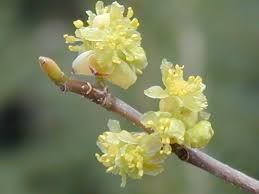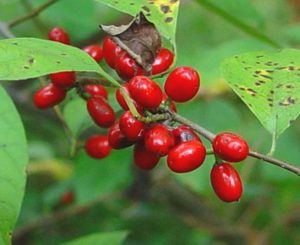I heard a fascinating lecture this week while attending MGIX, the annual conference of the Ohio Nursery and Landscape Association. The topic was landscaping for climate change.

Swallowtail butterfly visiting Monarda and Echinacea
The speaker, Kim Eierman, cited several statistics that demonstrate how the number of species of birds and invertebrates (e.g.butterflies) is diminishing, some by over 50%. I learned that there is something called the Xerces Society red lists that categorize the status of bees, butterflies and moths, and aquatic invertebrates. If you enter the word plants into the website search box, several articles will pop up that suggest plants we can use to encourage the survival of these invertebrates.

Cedar waxwing eating winterberry-RichardDay of Daybreak Imagery
Kim also spoke about the diminishment of bird species as well as the change in their habitat range. Robins, for instance, used to leave northern Ohio for the winter; now they remain and supplying them with winter food is crucial to their survival. I see them outside my office window, nibbling on frozen and shrunken crabapples. But what else can we plant for them? Some of the hollies, like winterberry and American holly, will fill the bill but we have to be sure that when we plant these dioecious species, we have mostly females because although the males are needed to pollinate them, the males do not bear fruit (sound like human sexuality?).

Lindera benzoin flowers-willowaynurseries.com

Lindera benzoin fruits-Missouri Plants.com
Biodiversity seems to be the main key but designing and planting for seasonal flowering and fruiting as well as habitat is also crucial. Early pollinators need to be fed, thus the need for more red maples, pussy willows, and Lindera benzoin instead of Forsythia. Lindera is a native while Forsythia is Asian. You know that I am not a rigid nativist but Lindera blooms early enough for the early pollinators and also supplies fruits for migrating birds as well as the Northern Cardinal that remains in its habitat through the winter.

Large mature trees
Healthy ecosystems are as valuable to humans as they are to wildlife, just in different ways. They supply clean air and water, climate regulation, pollination of food crops and flowering trees and shrubs, and prevent erosion. As part of these ecosystems, we need to plant more trees because they absorb carbon emissions and mitigate storm water runoff by intercepting raindrops with their canopies. In addition, two mature trees can provide enough oxygen for a family of four.
Everything I’ve mentioned here can be integrated into your landscapes and gardens if you are willing to give up great swaths of plants that have little function other than providing green boredom.


0 Comments